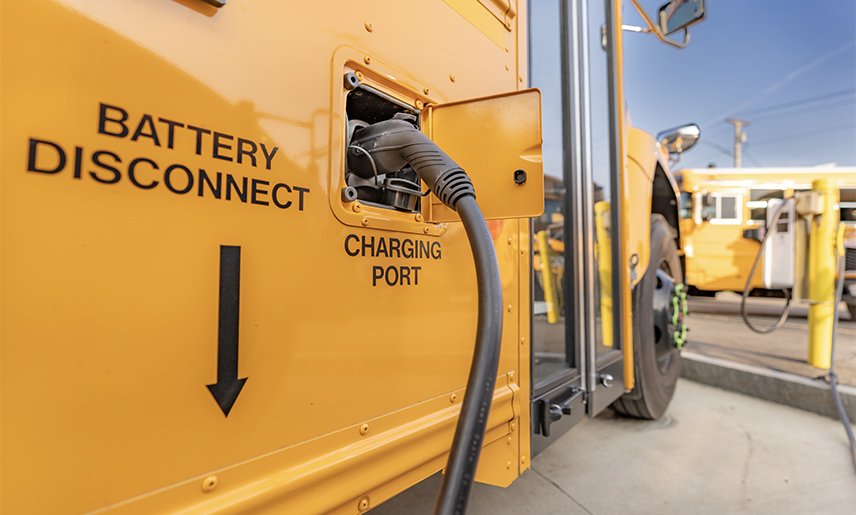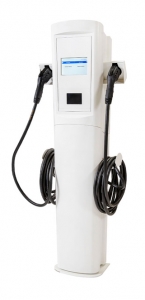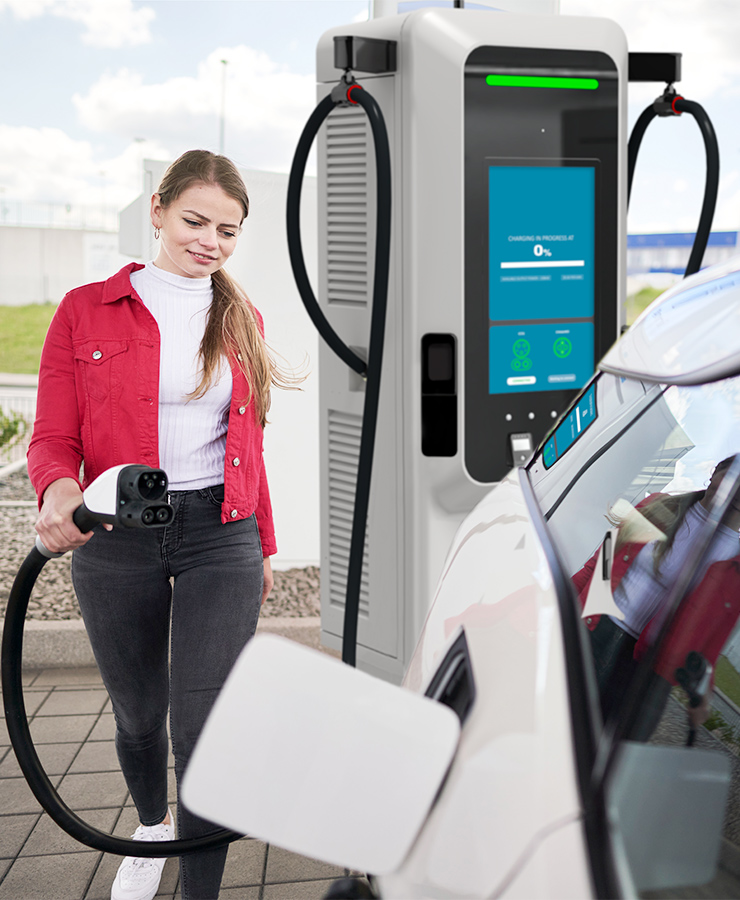
The transportation industry and fleet owners are slowly but steadily transitioning from internal combustion engine vehicles (ICE) to electric models (EVs). While the transition can be complex for fleet owners, EVs are gaining momentum. According to EV Sales Tracker, 8.8% of vehicle sales in 2023 were electric or hybrids, with projections for 2024 suggesting EV sales will set new records compared to previous years, with up to 13% of all sales attributed to EVs or hybrids.1
Fleets come in all shapes and sizes, spanning the range from cars used by a city or municipality to mid-sized vans for contractors, plumbers or florists, school buses, and heavy-duty trucks. Among recorded fleet vehicles in the US, trucks outnumber cars by almost two to one (Bureau of Transportation Statistics 2021 data). This is unsurprising since trucking fleets transport 72.5% of all American freight. And one significant cost for these trucking fleets is fuel, which accounts for 25% of the expenses for a truck fleet. Certain to face rising costs in the future, fleet owners and managers must start to look for alternatives.
Read about EV fleet solutions
Electric vehicles offer numerous benefits for fleet owners, including cost savings related to the fuel that powers the vehicle. There are differences in the cost of electricity to power up these vehicles depending on the region of the country and time of day, but one huge factor electric engines eliminate, particularly for truck fleets, is the cost of idling.
According to the Argonne National Laboratory (US Department of Energy), commercial fleets squander the vast majority of 6 billion gallons of gasoline and diesel fuel burnt annually due to vehicle idling. The costs related to idling can reach thousands of dollars per vehicle in just one year.2
In addition, electric trucks lower noise levels, generate less vibration than internal combustion engines, and reduce emissions. The questions that all fleet owners, particularly truck fleets, must answer are how quickly you can charge and how far you can travel on that charge.
Two types of commercial EV charging stations can keep EV fleets operations charged and ready for deliveries, routes, and runs: either Level 2 or DC fast chargers. Examining available options can help fleet owners decide which type might best serve the needs of their fleet operations.
Here are some of the deciding factors fleet owners and managers must consider to ensure constant charging availability:
- Fleet size and composition – the number and type of EVs in your fleet for the required charging capacity and infrastructure needs.
- Vehicle duty cycles – daily mileage, route patterns, dwell times, and locations of your vehicles to determine the appropriate charging levels.
- Site infrastructure – the electrical capacity, available space, and accessibility of potential charging locations for optimal capability and placement.
- Future growth – plans for fleet expansion and consider scalable or fast charging stations that can accommodate a growing EV adoption over time.
- Time requirements – your municipality may require permits, and electrical infrastructure may take time to install.
If all this appears too daunting, no fear. There are many different solutions, such as partnering recharging stations, fleet charging programs, EV charger solution providers, etc.
Examples of commercial EV fleets
The word “fleet” often conjures images of massive operations like Amazon delivery trucks or significant logistics companies. However, commercial fleets come in all shapes and sizes, from small, local businesses to mid-sized or regional operations, and expansive national or even global enterprises. The transition to electrify these fleets or move from ICE to EVs presents a broad range of benefits for organizations of any size.
While there are no definitive industry-wide standards for what constitutes “small,” “medium,” or “large” fleets, we can look at generalities to quantify fleets into categories. Additional factors might include vehicle types, operational needs, and industry specifics. For example, a privately owned trucking firm might have heavy-duty vehicles but few in number and, therefore, be classified as “small.”
Small EV fleet
Anywhere from one to 20 vehicles. Examples:
- Plumbing or catering firms
- Florists
- Contractors
- Private trucking companies
- Township vehicles
- Park districts
- Public works
- Police and fire departments
- Landscaping or pest control
While the larger the fleet, the greater the overall impact, the transition to an electric fleet can still pose significant benefits for the small fleet owner, who must be overly conscious of any capital spending. Depending on the size and types of vehicles in a small fleet, owner/operators can realize:
- Lower fuel and maintenance costs, as EVs have fewer moving parts than an ICE vehicle
- Potential tax incentives or rebates for EV adoption
- Quieter operations, which may be an important factor in residential areas
- Improved emissions footprint and environmental sustainability
Medium EV fleet
Range of 21 to 200 vehicles. Examples:
- Regional transportation/delivery companies
- Mid-sized municipalities
- School districts
- Public transit agencies
- Construction or engineering firms
- Road crews
- Local rental operations
- Utility companies
Transitioning to EVs offers mid-sized fleet owners a multitude of benefits, including:
- Significant fuel cost savings over time
- Reduced maintenance requirements compared to internal combustion engine vehicles
- Potential for centralized charging infrastructure
- Provides greater control over vehicle charging
- Enables fleet vehicles to charge when not in use, usually during non-peak electricity hours, for greater savings
- Makes charging available for fleet vehicles and visitors at any time
- Improved public image and commitment to sustainability
Large fleets
200 vehicles and more. Examples:
- National logistics and delivery companies
- Larger state or federal government agencies
- Postal service
- Military
- Park services
- Large corporations
- Rental agencies
- Public transit operations in major urban areas
The benefits for larger fleet owners to transition to electric vehicles might include:
- Substantial long-term cost savings on fuel and maintenance
- Ability to negotiate bulk purchases and implement large-scale charging infrastructure
- Significant reduction in emissions and environmental impact
- Progress towards sustainability pledges that can be shared with stockholders or for brand promotion
- Potential for partnerships or initiatives related to sustainable transportation
In addition, in a recent move that will impact heavy-duty trucks regardless of fleet size, the US Environmental Protection Agency (EPA) recently announced strict new emissions standards for heavy-duty trucks, buses, and other large vehicles for model years 2027 and forward.3 The rules are described as “complex.” However, fleet owners should be aware of new zero-emissions standards like this one and plan accordingly to remain compliant.
Regardless of the fleet size, transitioning to EVs can provide cost savings, environmental benefits, and potential incentives or rebates, making it an attractive option for several businesses and municipalities.
What type of commercial EV chargers should fleets use?
This question can best be answered by looking at the requirements of the fleet vehicles. For smaller vehicles with longer dwell times, such as cars or vans parked overnight, Level 2 chargers provide a cost-effective solution. Heavy-duty trucks may demand a Level 3 or DC fast charger depending on distance, time on the road, and other factors.

Level 2 chargers
Level 2 chargers are AC-powered units designed to handle either residential 240-volt outlets or commercial 208-volt outlets. These commercial EV chargers are smaller and less expensive for the initial capital outlay than DC fast chargers, as they require fewer components. Depending on variables like location and available electricity, the installation cost for a Level 2 charger could be less than $1,000 in some cases with the right setup.
A Level 2 charger can fully charge an empty EV battery in four to ten hours, making this charger suitable for scenarios where vehicles are parked for extended periods, such as overnight charging at depots or during longer dwell times. Some small business owners even charge their fleet of EV vehicles at home.
For small to medium-sized fleets of cars, vans, or light-duty trucks, Level 2 chargers like the L2 MaX 32, 48, 80 Amp from BTC POWER can supply a cost-effective solution. This industry-leading and cost-efficient high amp dual charger offers robust construction with dual ports capable of delivering 80 amps simultaneously to charge two vehicles at once.

DC fast EV chargers for fleets
Level 3 EV chargers, also known as DC fast chargers, are designed for rapid charging and are suitable for larger vehicles or quick charges in high-traffic areas. This type of charger does carry a higher installation cost than a Level 2. However, the time savings and the fleet requirements might dictate installing the DC fast charging unit. Also, the savings in fuel and maintenance realized with EVs will make level 3 EV commercial chargers very attractive.
These chargers output DC directly to the vehicle’s battery, bypassing the onboard AC to DC converter. DC fast chargers have kilowatt (kW) capabilities of 50 kW and up, with higher kW ratings translating to faster charging times.
Solutions like the GEN 4 All-in-One (AiO) DC Fast Charger from BTC offer powerful features tailored for heavy-duty truck fleets. With CCS-1 and CHAdeMO connector options, liquid-cooled cables capable of 500A continuous charging, and modular system architecture for future upgrades, these commercial EV chargers enable rapid replenishment of high-capacity batteries found in electric trucks. Available in 120kW, 150kW, or 180kW configurations, the GEN 4 AiO can be tailored to meet the specific energy demands of different fleet compositions.
Here is the most significant benefit of L3 EV chargers for fleets – depending on the type of DC fast charger, an empty battery can be fully charged anywhere from 15 minutes to less than an hour, making them ideal for heavy-duty truck fleets. Notably, 60 percent of all truck journeys are shorter than 310 miles (500 km) and, therefore, within the range achievable by EV trucks on a single charge.4 Fleet owners can rely on DC fast chargers to maximize asset utilization and eliminate range anxiety.
Fleet managers can determine the optimal mix of Level 2 and DC fast charging infrastructure by carefully evaluating operational requirements, vehicle types, charging needs, and installation costs. This strategic approach ensures seamless electrification and maximizes the benefits of electric mobility across the entire fleet. Work directly with a commercial EV manufacturer such as BTC POWER to determine the best solution for your fleet operations. Contact us for a quotation or to discuss your charging station needs.
1 https://www.caranddriver.com/news/a46340514/ev-sales-are-just-getting-started/
2 https://www.fleetio.com/blog/fleet-idling-costs
3 https://www.cbsnews.com/news/epa-emissions-standards-trucks-buses-climate-change/
4 https://www.assemblymag.com/articles/97520-heavy-duty-electric-trucks

